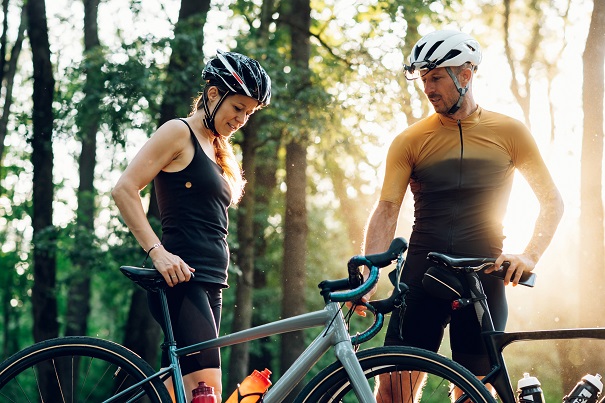The benefits of cycling are numerous, and the advantages can be both psychological and physical. For instance, riding a bike can improve your lower-half health, improve your balance, and increase your cardiovascular and respiratory fitness. It also helps to relieve stress. It can also help improve your mood.
Exercise boosts mood
Exercise is a great way to boost mood. It can help you reduce stress, improve your sleep, and even improve memory. In fact, it has been proven to increase positive feelings in adults, as well as reduce symptoms of depression. However, it can be difficult to motivate yourself to get started.
Although exercise has been shown to have health benefits it is not always immediately visible. For instance, people who don’t like to run may not make it through a workout long enough to reap the mental health rewards.
Research suggests that exercise is the best way to improve mood. Physical activity can help you feel better and maintain a healthy weight.
Another study found that exercise can boost your brain power. Exercise increases blood circulation to your brain, which helps your cognitive function. Exercise releases endorphins and other feel-good chemicals into the bloodstream. These chemicals can alleviate pain, regulate appetite, and increase pleasure.

Exercise can also help you to increase your resilience. Regular exercise can help you to bounce back from a difficult experience. This will help you deal with problems more effectively.
According to a National Institute of Mental Health study, regular exercise can increase your emotional resilience. This is particularly helpful for individuals suffering from depression.
When deciding how much exercise to do, there are many factors to consider. How active you are and how enjoyable it is will determine how much exercise you need. However, it is a good rule to spend no less than 20 minutes doing light to moderate aerobic exercise.
Exercise has the obvious benefit of reducing stress. Exercise can improve your mood, sleep, self-confidence, and mood.
Cardiorespiratory health
Cycling is an excellent form of cardiorespiratory exercise. It improves the strength of your heart, blood vessels, and lungs, as well as your mental well-being. The benefits of cycling include reduced risk of diabetes, stroke, high blood pressure, and cancer. You’ll also find that it’s fun.
There are many benefits to cycling. However, people with preexisting conditions should consult their doctor before they start. If you haven’t been physically active before, it’s recommended that you start slowly and gradually increase your workouts. A cycling class is a good place to begin. Many classes are positive and include high-intensity interval training. This can help you improve your heart health and blood pressure.
Regular cycling has been linked with a decreased risk of several types of cancer, including colon cancer. A study in Finland found that people who cycled for more than 30 minutes per day had a 40% lower chance of developing diabetes.
There have been studies that cycling has been shown to reduce the risk of type 2 diabetes and other conditions such as stroke, heart disease, high cholesterol, breast and bowel cancer, and coronary heart disease. It can also strengthen your lower half muscles, which can help you lose calories and prevent obesity.
There is a strong dose-response gradient between cycling and health benefits. Six studies have shown that riding more often leads to greater health benefits.
Numerous prospective observational studies have shown that cycling to work reduces the chance of dying from cardiovascular disease. Another study found an inverted relationship between commuter cycling, and cancer mortality.
Life expectancy is affected by your cardiorespiratory fitness. Studies have shown that regular cyclists have increased cardiorespiratory fitness, which means they can exercise longer and harder.
Lower-half health
Did you know that cycling is good to the lower half of your body. The good news is that cycling can be a great exercise for the lower half of your body. You should make the most out of it by pushing the limits. A good workout can be both fun and rewarding. Although you may need to push your body forward to get on the tarmac, you will be glad that it did. You’ll be the envy of your friends. One of my favorite things about cycling is the camaraderie that it engenders, especially when you’re a singleton. And who knows, you may just get lucky. If you’re not into riding, you may well be in the same boat.
Improves balance and proprioception
Balance and proprioception are essential in decreasing the risk of injury in sports. They are especially important in sports that have a high incidence of physical contact. Many sports, such as basketball and football, involve physical contact with their opponents.
Proprioception refers to the body’s internal perceptions of its position and orientation. It is mediated through receptors on the skin and joints. These signals are processed by the brain which then sends control commands to the muscles to fine-tune movements.
Researchers have used a variety of biomechanical measures to determine the contribution of proprioceptive signals to balance control. Researchers have used a variety of biomechanical measures to determine the contribution of proprioceptive signals to balance control, including electromyographic signals and joint kinematics.
In order to determine the effects of exercise on proprioception, a randomized controlled trial was conducted with 36 older adults. Randomly, participants were assigned to either a balance exercise or falls prevention education group. The intervention resulted in a reduction of age-related differences at baseline. However, these improvements did not continue after 8 weeks.
A separate study examined the impact of a 10-minute warm up on proprioception. During the warm-up, the participants performed a variety of exercises.
Compared with the non-specific exercise group, the proprioceptive exercise group had better results. They had higher BESS test scores, velocity discrimination, joint position sense, and BESS test scores. As well, the number of non-responders to the Y-balance test was lower in the group that did the proprioceptive exercise.
Another study evaluated the effects of a single session of proprioceptive exercise on young athletes. Participants used the BOSU to perform a variety exercises to increase awareness of the lower and upper limbs.



